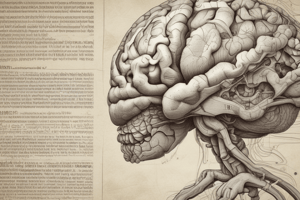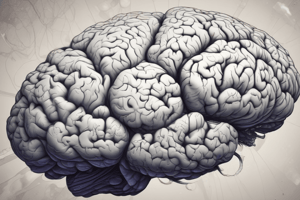Podcast
Questions and Answers
Which of the following is NOT a risk factor for CVA?
Which of the following is NOT a risk factor for CVA?
- Hypertension
- Obesity (correct)
- Atrial fibrillation
- Atherosclerosis
A transient ischemic attack (TIA) can occur without any acute infarction.
A transient ischemic attack (TIA) can occur without any acute infarction.
True (A)
What is the main goal of rehabilitation after a stroke?
What is the main goal of rehabilitation after a stroke?
- To improve communication skills
- To decrease hospital stay
- To prevent further strokes
- To enhance recovery of functional abilities (correct)
What is the medical term for the inability to understand words or to respond appropriately?
What is the medical term for the inability to understand words or to respond appropriately?
Incomplete spinal cord injuries result in complete loss of function below the level of injury.
Incomplete spinal cord injuries result in complete loss of function below the level of injury.
A stroke caused by a rupture of a blood vessel in the brain is called a __________ stroke.
A stroke caused by a rupture of a blood vessel in the brain is called a __________ stroke.
Match the signs and symptoms of stroke with their definitions:
Match the signs and symptoms of stroke with their definitions:
What type of spinal injury is characterized by loss of motor function on the same side and loss of pain and temperature perception on the opposite side?
What type of spinal injury is characterized by loss of motor function on the same side and loss of pain and temperature perception on the opposite side?
The _____ layer of the meninges is the outermost and provides the first line of protection to the spinal cord.
The _____ layer of the meninges is the outermost and provides the first line of protection to the spinal cord.
Which treatment option may be used for CVA to help prevent clot formation?
Which treatment option may be used for CVA to help prevent clot formation?
Match the type of spinal cord injury with its description:
Match the type of spinal cord injury with its description:
After experiencing a stroke, a patient will always regain complete independent functioning.
After experiencing a stroke, a patient will always regain complete independent functioning.
The type of stroke caused by an obstruction of a blood vessel is referred to as __________ stroke.
The type of stroke caused by an obstruction of a blood vessel is referred to as __________ stroke.
Which imaging study is most commonly used to visualize the spinal cord and vertebrae?
Which imaging study is most commonly used to visualize the spinal cord and vertebrae?
Spinal shock can occur immediately after a spinal cord injury.
Spinal shock can occur immediately after a spinal cord injury.
Identify one major risk associated with spinal cord injuries at or above level C5.
Identify one major risk associated with spinal cord injuries at or above level C5.
The function of the ________ is to serve as a shock absorber for the vertebral column.
The function of the ________ is to serve as a shock absorber for the vertebral column.
What is the typical number of vertebrae in the human vertebral column?
What is the typical number of vertebrae in the human vertebral column?
What is the primary goal of treatment during the acute phase of a stroke?
What is the primary goal of treatment during the acute phase of a stroke?
A patient experiencing hemiplegia has paralysis on both sides of their body.
A patient experiencing hemiplegia has paralysis on both sides of their body.
Name one type of ischemic stroke.
Name one type of ischemic stroke.
In the rehabilitation phase, it is essential to assist the patient in returning to the highest __________ level possible.
In the rehabilitation phase, it is essential to assist the patient in returning to the highest __________ level possible.
Which of the following is NOT a common complication following a stroke?
Which of the following is NOT a common complication following a stroke?
Transient Ischemic Attack (TIA) is often seen as a warning sign of an impending full stroke.
Transient Ischemic Attack (TIA) is often seen as a warning sign of an impending full stroke.
What medication is used to dissolve clots in acute ischemic strokes if administered within 3 hours of symptoms onset?
What medication is used to dissolve clots in acute ischemic strokes if administered within 3 hours of symptoms onset?
What are some signs and symptoms of a hemorrhagic stroke?
What are some signs and symptoms of a hemorrhagic stroke?
Dysphagia refers to difficulty with __________.
Dysphagia refers to difficulty with __________.
What type of aphasia involves difficulty understanding spoken or written language?
What type of aphasia involves difficulty understanding spoken or written language?
Match the type of stroke with its description:
Match the type of stroke with its description:
What is the duration of the acute phase of treatment?
What is the duration of the acute phase of treatment?
A patient with homonymous hemianopsia may only see one side of their visual field.
A patient with homonymous hemianopsia may only see one side of their visual field.
Patients with __________ neglect may not recognize one side of their body as part of themselves.
Patients with __________ neglect may not recognize one side of their body as part of themselves.
Flashcards are hidden until you start studying
Study Notes
Cerebrum
- Composed of two hemispheres, each controlling opposite sides of the body.
- Right hemisphere is linked to emotional, artistic abilities; controls the left side.
- Left hemisphere is often dominant, responsible for language, math, and reasoning; controls the right side.
Circulation
- The brain consumes 20% of the blood's oxygen supply every minute.
Transient Ischemic Attack (TIA)
- A temporary neurological deficit caused by reduced cerebral blood flow.
- Can occur due to spasms, plaque fragments, or blood clots.
- Warning signs for an impending stroke include dizziness, confusion, speech loss, balance issues, tinnitus, and visual disturbances.
- Diagnosed via MRI; carotid artery bruit may indicate partial obstruction.
- Treated with aspirin, clopidogrel, warfarin, heparin, and procedures like carotid endarterectomy.
Stroke (Cerebrovascular Accident - CVA)
- Defined as abrupt impairment of brain function lasting over 24 hours due to impaired blood flow.
- Results in neurological signs and symptoms.
- Types include:
- Hemorrhagic Stroke: Blood vessel rupture causes bleeding in the brain; sudden symptoms include severe headache, stiff neck, loss of consciousness, vomiting, seizures.
- Intracerebral: Within cerebral hemispheres.
- Subarachnoid: Between meningeal layers.
- Ischemic Stroke: Obstruction of blood vessels impeding flow, causing tissue death due to plaque or clots.
- Embolic Stroke: Clot travels and lodges in a cerebral artery.
- Thrombotic Stroke: Thrombus forms from narrowed arteries due to plaque.
- Lacunar Stroke: Affects small, deep arteries, often resulting in mild symptoms.
- Hemorrhagic Stroke: Blood vessel rupture causes bleeding in the brain; sudden symptoms include severe headache, stiff neck, loss of consciousness, vomiting, seizures.
Signs and Symptoms of Stroke
- Varied symptoms depending on stroke type, injury location, and relation to oxygen deprivation.
- Aphasia: Deficits in language use.
- Receptive: Difficulty understanding language.
- Expressive: Difficulty speaking or writing.
- Global: Difficulty in all communication forms.
- Dysarthria: Unclear speech.
- Dysphagia: Swallowing difficulties.
- Hemiplegia: Paralysis on one side of the body.
- Sensory impairment: Inability to feel touch, pain, or temperature.
- Unilateral neglect: Lack of awareness of one side of the body.
- Homonymous hemianopsia: Loss of one visual field side.
- Neurogenic bladder and bowel incontinence may occur.
Complications Post-Stroke
- Common complications include constipation, dehydration, urinary tract infections, contractures, decubitus ulcers, and pneumonia.
Prognosis
- Long-term recovery is influenced by immediate post-stroke care.
- Significant recovery typically occurs within the first 3 to 6 months, with continued improvement possible.
Medical Treatment: Acute Phase
- Initiated upon symptom onset, lasts 24-48 hours.
- Goals: Minimize complications, stabilize vital signs.
- High blood pressure management is crucial.
- Monitor oxygenation; oxygen therapy required if O2 saturation drops below 94%.
- Manage hyperthermia and hyperglycemia with appropriate medications.
- Use rt-PA for thrombolysis in acute ischemic cases; must be administered within 3 hours.
- Mannitol for cerebral edema; medications like phenytoin for seizures.
Nursing Care: Acute Phase
- Conduct thorough physical examination; assess responsiveness, vital signs, and neurological status.
- Elevate head of bed 25-30 degrees; assess swallow and gag reflex.
- Prevent complications like aspiration and immobility.
- Monitor for hemorrhage related to medications.
Nursing Care: Rehabilitation Phase
- Focus on returning patients to highest functional level with encouragement in activities of daily living (ADLs).
- Utilize adaptive equipment and modify environments for independence.
- Patients with homonymous hemianopsia should have objects placed in affected visual field to stimulate awareness.
Discharge Planning
- Transition patients home or to rehabilitation facilities, involving family and resources for support.
- Ongoing rehabilitation challenges patients toward functional ability restoration.
Spinal Cord Injuries
- Spinal column consists of 33 vertebrae: 7 cervical, 12 thoracic, 5 lumbar, 5 sacral, and 4 coccygeal.
- Disk structure: Anulus fibrosus (outer layer) and nucleus pulposus (gelatinous center) serve as shock absorbers.
- Spinal cord extends from the brainstem to L2, enveloped by three protective meningeal layers (dura mater, arachnoid, pia mater).
- Imaging tests for spinal injuries include X-rays, CT, MRI, and myelograms.
Types of Spinal Cord Injuries
- Classified as closed (intact skin and meninges) or open (damage to protective coverings).
- Complete injury: Full severing of the spinal cord.
- Incomplete injury: Partial cutting leaves some function.
Effects of Spinal Cord Injury
- Higher injuries lead to greater dysfunction.
- Central cord syndrome: Hyperextension causes motor/sensory loss in upper extremities.
- Brown-Sequard syndrome: Ipsilateral motor loss and contralateral pain/temperature loss.
- Quadriplegia: paralysis from high cervical injuries, affecting all four extremities.
- Paraplegia: lower body paralysis from injuries at T2 or below.
Respiratory Impairment and Spinal Shock
- High cervical injuries impact respiration; injuries above C5 can be lethal.
- Spinal shock: Temporary response leads to flaccid paralysis, masking injury extent.
Autonomic Dysreflexia
- A condition affecting individuals with spinal cord injuries, leading to dangerous hypertension in response to stimuli below the injury level.
Studying That Suits You
Use AI to generate personalized quizzes and flashcards to suit your learning preferences.




